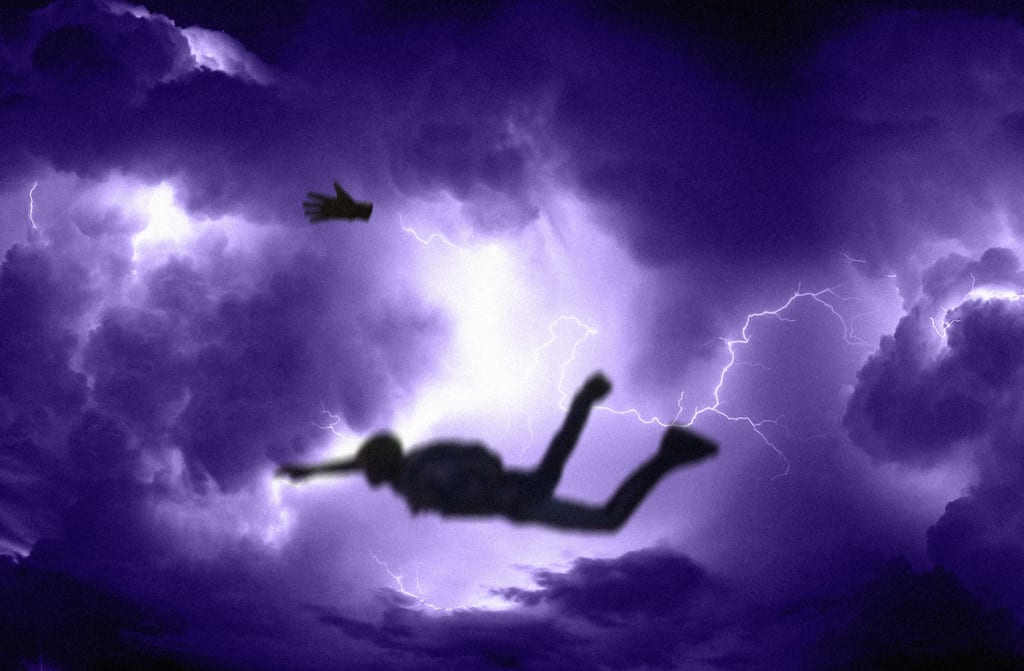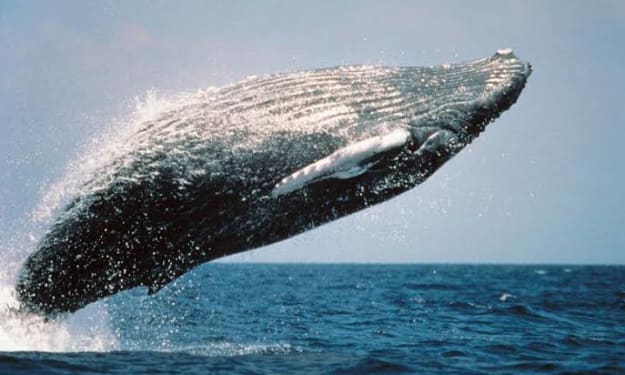The Man That Rode the Thunder
Defying Death at 40,000 Feet: A Tale of Courage, Perseverance, and the Indomitable Human Spirit

There are few survival stories that can match the incredible miracle that occurred to Marine lieutenant colonel William Henry Rankin in 1959. Allow me to share with you the extraordinary account. On an unfortunate day, this man experienced a near-drowning incident while falling from the sky. If you find it hard to believe, please take a moment to listen to this story.
In July 26, 1959, Rankin was piloting his F8 Crusader, a single-engine supersonic aircraft, along the North Carolina coast at an altitude of over 47,000 feet. Accompanied by his wingman, Navy Lieutenant Herbert Nolan, their jets, nicknamed "candy stripers" due to their unique orange and silver-gray coloring, were swiftly navigating through the sky. Although there was a storm raging below, it didn't pose any immediate threat. Their destination was the Marine Air Base in Beaufort, South Carolina, and they were scheduled to pass through the storm on their way.
However, things took a turn for the worse when, just nine miles away from the military base and a few minutes from their destination, Rankin's engine suddenly failed, and the fire warning light illuminated. With no power and unable to restart the engine, Rankin knew his options were limited. Desperately attempting to prevent his plane from nosediving, he radioed his partner, Lieutenant Nolan, with the message "failure, I have to..." It was a terrifying decision to make, considering the extreme altitude and the absence of a pressure suit.
The only hope for survival was an oxygen mask with a limited oxygen supply. Without hesitation, Rankin pulled the overhead handle to eject, and within moments, he was airborne while his plane vanished into the clouds below. Now, Rankin found himself in a free fall at an altitude of 40,000 feet, with a bone-chilling temperature of minus 65 degrees Fahrenheit.
Ordinarily, sports skydivers jump from heights of 3,500 to 10,000 feet, and only highly experienced professionals dare to jump from altitudes exceeding 15,000 feet. Even then, it can lead to serious complications if they lack the necessary equipment, including a pressure suit. Consequently, when Rankin found himself in the air at such an unprecedented altitude, he experienced severe decompression. His stomach felt as if it had doubled in size, and his nose seemed on the verge of exploding. Bleeding from his eyes, ears, and mouth, Rankin was certain that the decompression would claim his life in an instant.
Little did he know that an even more severe trial awaited him. Rankin continued to fall, and all he could feel, aside from overwhelming fear, was the shocking cold. His wrists and ankles burned as if exposed to ice, and his left hand went numb after losing one of his gloves during the ejection. To make matters worse, he remained in free fall.
Although Rankin had a parachute, it was designed to deploy automatically at 10,000 feet. Even if he had chosen to open it manually, it would have been impossible under the circumstances. In a matter of seconds, at an astonishing speed, he plummeted into the storm he had been flying above just minutes ago. And there, another calamity occurred.
Falling through the black clouds with limited visibility, Rankin endured approximately five minutes of lightning, rain, hail, and violent winds when the barometer that was supposed to deploy his parachute prematurely activated due to the violent weather. As a result, he became trapped in the heart of a thunderstorm, but not just any ordinary storm. The unlucky 39-year-old fighter pilot was swallowed by a cumulonimbus cloud.
Cumulonimbus clouds, resembling colossal puffy mushrooms, are incredibly dense and typically form in areas with extremely unstable atmospheric conditions. These vertical clouds can reach heights of up to 70,000 feet, and the taller they are, the more unstable and violent they become inside.
Thus, Rankin found himself in this precarious situation after his parachute opened prematurely. Even if it had deployed at the intended altitude of 10,000 feet, he would have been sucked back up into the cloud by the updraft. In any case, his body was tossed around like a ragdoll, repeatedly hitting the parachute fabric and then plummeting back down. The tossing was so severe that even the experienced fighter pilot felt seasick. Lightning crackled and snapped around him, vibrating through his body, although he couldn't hear the thunder itself.
The hailstones were immense, and Rankin worried they would tear his parachute. In the midst of the storm, he even feared drowning as he struggled to breathe while inhaling mouthfuls of water. Remaining in that region of the storm would have brought the frightening possibility of drowning while falling through the air. Attempting to hold his breath was equally perilous due to the high-speed descent.
Meanwhile, Rankin was being propelled up and down, at times experiencing altitude changes of up to 5,000 feet. It felt as though he had been falling for an eternity, enduring constant compressed air blasts. Fortunately, both good and bad things come to an end. Finally, after over 40 harrowing minutes, Rankin reached the base of the cumulonimbus tower.
To his astonishment, Rankin discovered that he had emerged relatively unscathed. The lightning had not struck him, his parachute remained intact, and he had not drowned in the rainwater. The only concern now was a safe landing. Initially descending toward a clearing, his luck took another turn for the worse when a powerful gust of wind suddenly threw him into a tree. His parachute became entangled in the branches, and he struck his head on the trunk. Fortunately, he was still wearing his helmet and didn't lose consciousness.
After freeing himself and regaining his footing, Rankin hobbled through the forest until he reached a country road. However, hitching a ride proved challenging, considering his bloodied appearance and soaked, torn flight suit. Understandably, few volunteers were eager to give him a lift. Eventually, someone stopped and drove him to a pay phone, where Rankin managed to call for an ambulance.
It was then that he truly realized how fortunate he was. His body was covered in countless bruises and welts, and he suffered from the effects of severe decompression and frostbite. However, aside from these temporary injuries, the ordeal left no long-term damage. Rankin spent several weeks in the hospital and made a complete recovery. He later chronicled his experience in the book "The Man Who Rode the Thunder."
In conclusion, the survival story of Marine lieutenant colonel William Henry Rankin in 1959 is a truly remarkable tale of resilience and courage. Facing a sudden engine failure at an extreme altitude, Rankin made the harrowing decision to eject from his aircraft, plunging into a free fall from 40,000 feet. Enduring severe decompression, violent thunderstorms, and the constant threat of drowning, Rankin miraculously survived over 40 agonizing minutes before landing on the forest floor.
His ordeal serves as a testament to the indomitable human spirit and the will to survive against all odds. Despite the overwhelming challenges he faced, Rankin emerged relatively unscathed, eventually recovering from his injuries. His story not only showcases the incredible resilience of the human body but also highlights the importance of quick thinking, adaptability, and the determination to never give up.
Rankin's survival against such extraordinary circumstances serves as an inspiration, reminding us of the extraordinary potential we possess when faced with life-threatening situations. His account serves as a reminder to cherish life, to appreciate the power of human resilience, and to never underestimate the strength of the human spirit in the face of adversity.





Comments
Mela Mandigma is not accepting comments at the moment
Want to show your support? Send them a one-off tip.